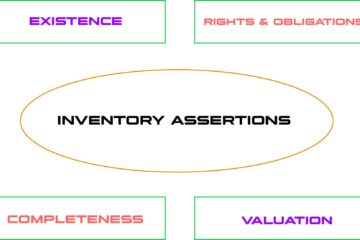Inventory is one of the main items of the statement of profit or loss and needs to be recorded accurately. To check whether the internal control system for counting & recording the inventory works in an intended way, the auditor performs tests of controls in the audit. There are a lot of inventory tests of controls procedures that are used by auditors.

There are FOUR key assertions for inventory which are as follows:
- Valuation
- Completeness
- Existence
- Rights & Obligations
Normally, the main source that we, auditors, use as evidence is the year-end inventory count. If it is practicable to do so, we attend the year-end inventory count or continuous and perpetual counts throughout the year. In simple terms, if the inventory is material to the financial statements, the auditor attends inventory counts if it is practicable to do so, and performs thorough procedures on the inventory records to make sure it is recorded correctly.
ISA 501 requires the auditor to obtain sufficient appropriate evidence regarding the existence & condition of inventory. To comply with the standard, the auditor performs tests of controls on inventory to gather the required “sufficient and appropriate” evidence. So, how does the auditor perform inventory tests of controls?
Performing the Inventory TOCs
The most important and basic inventory test of control is to attend the inventory counts of the client which requires the auditor to:
- Analyze the management’s plan & procedures for the inventory count
- Observe the performance of the count while it’s been undertaken
- Inspect the inventory for damages and obsolescence and perform test counts to ensure the management’s count is accurate.
Inventory is sometimes held by third parties for reasons like lack of space, security issues etc… If the client’s inventory is parked with third parties, the auditor should apply the following inventory tests of controls:
- Obtain external confirmation from the third party regarding the quantity & condition of the goods. It confirms the assertions of rights and valuation.
- The auditor should attend the inventory count if it is material to the financial statements of the client. It confirms the inventory assertion of existence.
- The auditor should obtain reports from the auditor of the third party to confirm whether the third party’s internal controls are reliable.
General Inventory Tests of Controls
There are some general inventory Tests of Control procedures that an auditor uses to confirm the existence, completeness, valuation, and rights & obligations of the client’s inventory. The Inventory tests of controls are:
- Observe the security of the inventory and the environment in which it is held.
- Apply procedures on recording the inventory and the in and out inventory movements.
- Test authorization for disposal, write-offs or scrapping of inventory items.
- Check whether the sequences of dispatch and Goods Received Notes (GDNs) are complete.
- Check whether the inventory reconciliations have been updated.
- Test controls over recording of inventory movements belonging to third parties that are held by the client.
The above are some inventory tests of control procedures that are applied generally and can be used for different types of inventory control systems. The purpose of carrying out these inventory tests of controls is to ensure the client’s system records, reports, and measures inventory balances reliably.
The key thing here is that if in the assessment phase, the auditor finds out that the client’s inventory control system is not reliable, they will more likely choose to perform thorough procedures considering the higher control risk. If the system is found to be designed effectively, the auditor may choose to perform fewer procedures and will rely on the internal control system for the better half.
